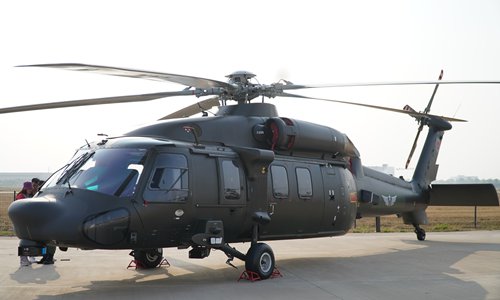
A Z-20 utility helicopter is on display prior to the 5th China Helicopter Exposition in Tianjin on October 9, 2019. Photo: Xu Luming/GT
The People's Liberation Army (PLA) Xinjiang Military Command has commissioned China's newly developed, plateau-capable utility helicopter, the Z-20. Observers noticed on Monday that the choppers seem to have modified engines that could boost their performance and survivability.
The command troops vowed to safeguard China's western border after recently conducting helicopter exercises over Pangong Tso on the China-India border Line of Actual Control (LAC).
A senior Indian official recently claimed that the Indian troops had "transgressed more times than the Chinese soldiers along the LAC," The Hindu reported.
In addition to Z-10 and Mi-171 helicopters, Z-20 helicopters are seen in footage released on Saturday by China Central Television (CCTV) introducing an army aviation brigade affiliated with the PLA Xinjiang Military Command, indicating the Z-20 has entered service with the command, analysts said.
The brigade, dubbed the Tianshan Eagles, is responsible for the defense of nearly 7,000 kilometers of China's western border line, ranging from snowy mountains to deserts, CCTV said.
Having made its public debut at the National Day military parade on October 1, 2019 in Beijing, the Z-20 features powerful, domestically developed engines and rotors built with anti-icing and de-icing technology that allow it to fly despite low oxygen levels at high altitudes and harsh cold, according to the helicopter's maker Aviation Industry Corp of China,
as quoted in previous reports.
Unlike previously observed Z-20 helicopters that had engine exhaust openings facing outward, the choppers used by the Xinjiang Military Command have engine exhaust openings facing upward, judging from the CCTV video, observers noted.
The modified exhaust openings could mean that these helicopters had been optimized to reduce disruption between different equipment to provide better performances, or more importantly, to reduce their infrared signatures so the helicopters could gain survivability as they would be less likely to get locked on by hostile anti-aircraft fire, Wang Ya'nan, a military aviation expert and chief editor of Beijing-based Aerospace Knowledge magazine, told the Global Times on Monday.
Wang said that the Z-20 could also undergo different modifications, based on the environment where it is to be deployed and its mission objective.
PLA Xinjiang Military Command army aviation troops recently conducted a series of combat-oriented exercises including low-air defense penetration, as their Mi-171 helicopters flew over Pangong Tso, a lake divided by the LAC on the China-India border, CCTV reported separately on Sunday.
India's Union Minister of State for State Transport and Highways V. K. Singh said on Sunday that "if China has transgressed 10 times [along the LAC], we must have done it at least 50 times."The remark was regarded as a public admission that India should be accountable for border disputes.
Chinese Foreign Ministry Spokesperson Wang Wenbin said on Monday that India has frequently transgressed the LAC in an attempt to encroach on China's territory and constantly created friction, which is the root of the border tension.
"We urge India to earnestly implement the consensus and the agreement reached by the two countries and take concrete actions to safeguard peace and stability in the border areas," Wang said.
India has never forsaken its ambition to gnaw away at China's territory. It either transgressed the boundary line which has been clearly defined, such as moves seen during the Doklam standoff in 2017, or crossed the LAC. Those people included soldiers, farmers and Tibetan exiles, Zhang Yongpan, a research fellow of the Institute of Chinese Borderland Studies of the Chinese Academy of Social Sciences (CASS), told the Global Times on Monday.
Zhao Gancheng, director of the Center for Asia-Pacific Studies at the Shanghai Institute for International Studies, told the Global Times that although there is still a gap between China and India's interpretations of the LAC, both countries should respect the fact and maintain peace and stability along the border, which is also the consensus of the top leaders of the two countries.
India's top leaders should pay attention to Singh's remarks and prohibit officials from making "provocative remarks that ravage the larger picture of India-China relations," Zhao noted.
On
January 24, China and India held the ninth round of the Corps Commander Level Meeting, in which both sides agreed to push for an early disengagement of the frontline troops and make continued efforts to stabilize and control the border situation, Chinese Ministry of National Defense said.
India's attitude toward the border issue lacks seriousness. It often and regularly violates the consensus reached by the two countries, Zhao said. "Provoking China will not bring any benefit to India, and India will not gain an inch of land because of its remarks," Zhao said.
As the Spring Festival holidays edge near, PLA border defense troops said that they will remain in position and safeguard China's territory and airspace, CCTV reported.




